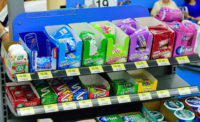Checkout lines — the term may bring up memories of impatient people, tantrums from children, and the unmistakable feeling of being bored and stressed at the same time.
Which is precisely why checkout dynamics are so important to business. After all, it’s a $5.5-billion industry and accounts for 1 percent of supermarket sales.
The current average supermarket purchase is $31.71 without a checkout item, but $34.50 with.
The key is to “make a lasting impression at checkout,” says Cameron Cloeter, president and found, Impulse Marketing Co.
While shoppers experience an emotional high at the beginning of their trip to the grocery store, their mood reaches an emotional low by the time they reach checkout.
But how to raise that emotional high?
“Eliminating merchandise isn’t the answer — it’s lack of labor that’s the annoying part. Merchandising quickens the mental time,” says Cloeter.
Focusing on shoppers’ needs to drive conversion rates is one important strategy. One in three shoppers won’t switch lanes to buy an item. Stocking all checkout lines with top-selling items solves this problem.
Three key merchandising principles include: consistency, location, and allocation, according to Cloeter.
Currently, checkout trends include flexible end caps, fresh and healthy food, and beverages and snacks. When designing merchandising and allocating space, Cloeter recommends planning for future trends.
Design elements can include shelf spacing, depth of shelves, pitch of shelves, lighting enhancements such as LED lights, and strategic pairing, such as beverages with snacks.
In terms of growth, from 2010-2014, total confections was at 10.4 percent, beverages, 142.5 percent, and gum and mints, 55.8 percent. Meanwhile, magazines are dying at -49 percent, yet they usually take up 40 percent of the space in a checkout lane.
And self-checkouts, which get 40 percent of the traffic at checkout, are also an important player in the game. Self-checkout lanes should include best-selling candy and snacks as well.
As checkout sales are ever-vital to the health of a grocery store, necessary steps should be taken to ensure the maximum profit possible.









